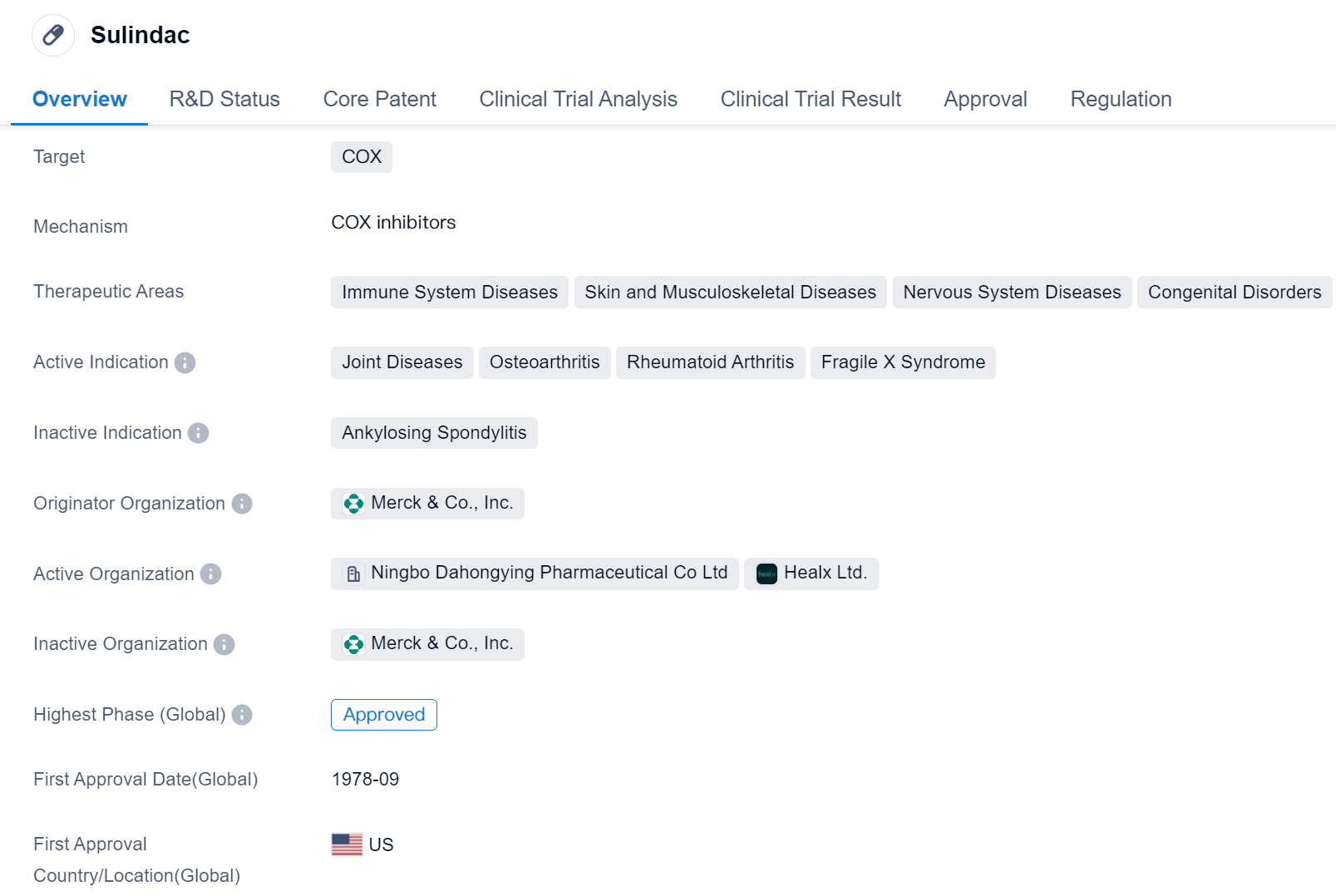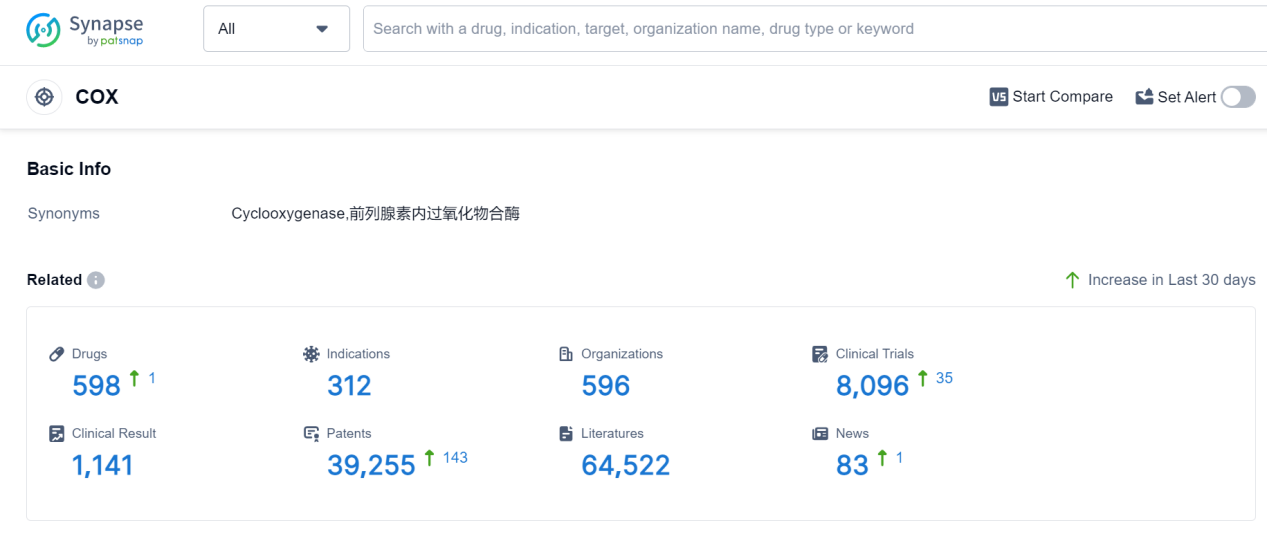Sulindac Unveiled: A Detailed Overview of its Revolutionary R&D Breakthroughs
Sulindac's R&D Progress
Sulindac is a small molecule drug that belongs to the class of nonsteroidal anti-inflammatory drugs (NSAIDs). It primarily targets the enzyme cyclooxygenase (COX), which plays a crucial role in the production of prostaglandins, substances that mediate pain and inflammation in the body. By inhibiting COX, sulindac helps alleviate symptoms associated with various immune system diseases, skin and musculoskeletal diseases, nervous system diseases, and congenital disorders.
The active indications for sulindac include joint diseases, osteoarthritis, rheumatoid arthritis, and Fragile X syndrome. Joint diseases encompass a range of conditions affecting the joints, such as inflammation, pain, and stiffness. Osteoarthritis is a degenerative joint disease characterized by the breakdown of cartilage and the underlying bone. Rheumatoid arthritis, on the other hand, is an autoimmune disorder that causes chronic inflammation in the joints. Fragile X syndrome is a genetic disorder that leads to intellectual disabilities and behavioral challenges.
Sulindac was developed by Merck & Co., Inc., a renowned pharmaceutical company. It received its first approval in the United States in September 1978, making it one of the early drugs in its class to be introduced to the market. The drug has since gained approval in various countries globally, indicating its widespread recognition and acceptance.
In terms of regulatory status, sulindac is classified as an orphan drug. Orphan drugs are medications developed to treat rare diseases or conditions that affect a small number of individuals. This designation provides certain incentives to pharmaceutical companies, such as extended market exclusivity and financial support, to encourage the development of treatments for these rare conditions.
👇Please click on the image below to directly access the latest data (R&D Status | Core Patent | Clinical Trial | Approval status in Global countries) of this drug.
Mechanism of Action for Sulindac: COX inhibitors
COX inhibitors are a class of drugs that act by inhibiting the activity of cyclooxygenase (COX) enzymes. COX enzymes are responsible for the production of prostaglandins, which are chemical messengers involved in inflammation, pain, and fever. By inhibiting COX enzymes, COX inhibitors reduce the production of prostaglandins, leading to anti-inflammatory, analgesic (pain-relieving), and antipyretic (fever-reducing) effects.
From a biomedical perspective, COX inhibitors are commonly used in the treatment of various inflammatory conditions, such as arthritis, and for pain management. They can help alleviate symptoms by reducing inflammation and relieving pain. Some examples of COX inhibitors include nonsteroidal anti-inflammatory drugs (NSAIDs) like aspirin, ibuprofen, and naproxen, as well as selective COX-2 inhibitors like celecoxib.
It's important to note that while COX inhibitors can be beneficial, they may also have potential side effects, particularly on the gastrointestinal system, including stomach ulcers and bleeding. Therefore, it is essential to use these medications under the guidance of a healthcare professional and to follow the recommended dosage and duration of treatment.
Drug Target R&D Trends for Sulindac
COX, or cyclooxygenase, is an enzyme that plays a crucial role in the human body's inflammatory response. It is responsible for the production of prostaglandins, which are hormone-like substances involved in various physiological processes. COX exists in two isoforms, COX-1 and COX-2. COX-1 is constitutively expressed and involved in maintaining normal bodily functions, such as protecting the stomach lining and regulating blood clotting. On the other hand, COX-2 is induced during inflammation and is primarily responsible for the production of prostaglandins that cause pain, fever, and swelling. Understanding the role of COX has led to the development of drugs called COX inhibitors, which are used to manage pain, inflammation, and other related conditions.
According to Patsnap Synapse, as of 7 Sep 2023, there are a total of 598 COX drugs worldwide, from 596 organizations, covering 312 indications, and conducting 8096 clinical trials.
👇Please click on the picture link below for free registration or log in directly if you have a freemium account, you can browse the latest research progress on drugs, indications, organizations, clinical trials, clinical results, and drug patents related to this target
Conclusion
Overall, sulindac is a small molecule drug that targets COX and is approved for the treatment of joint diseases, osteoarthritis, rheumatoid arthritis, and Fragile X syndrome. Developed by Merck & Co., Inc., it has been on the market since 1978 and holds orphan drug status. Its approval in multiple countries highlights its efficacy and potential in addressing various medical conditions related to the immune system, skin and musculoskeletal system, nervous system, and congenital disorders.






